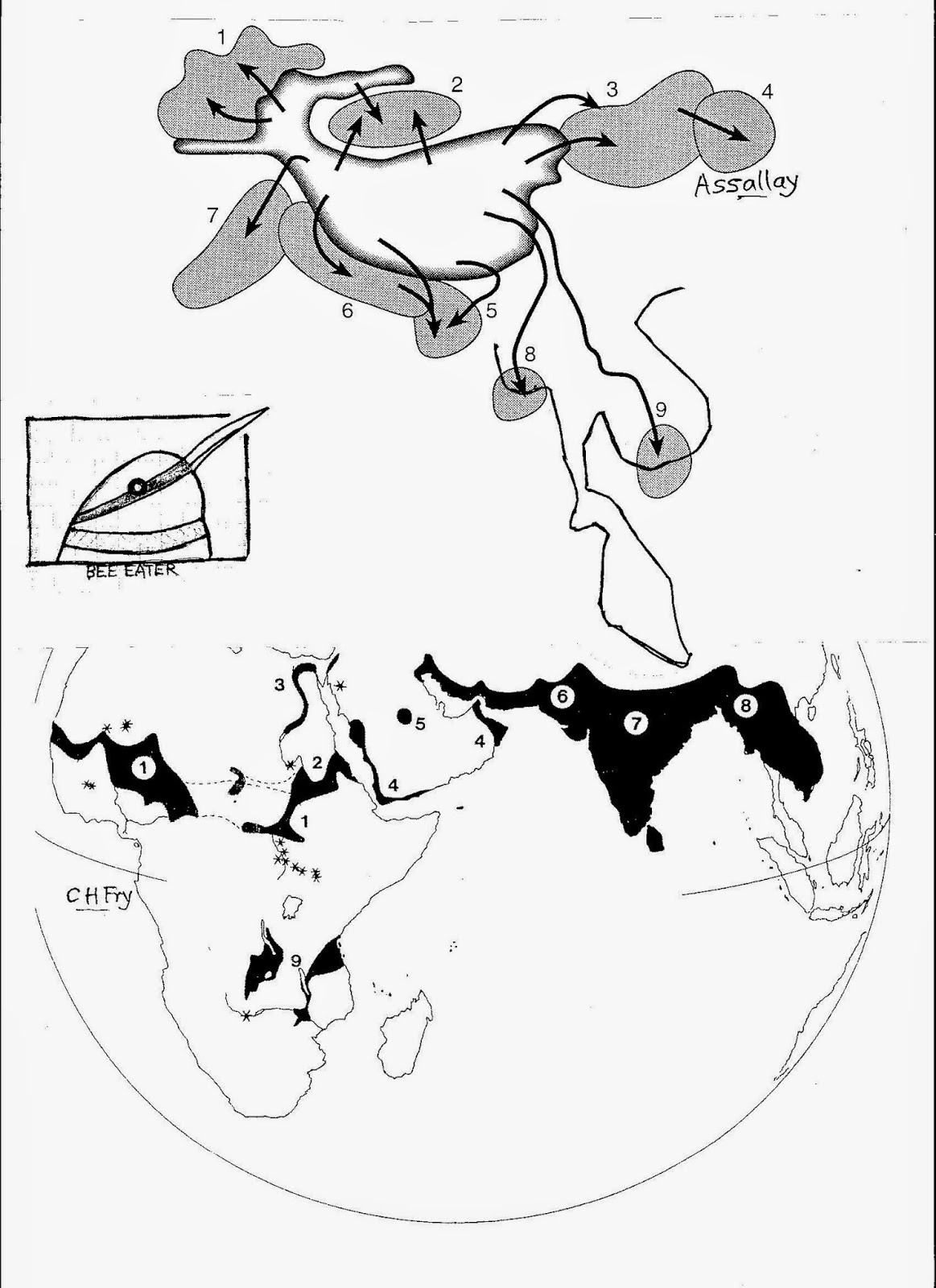The Loess & Bee-eaters project is developing. Bee-eater birds (family Meropidae) like to nest in loess tunnels- a study of this aspect of their behaviour should throw some light on the nature of loess ground and on the behaviour of the birds. Soil Mechanics meets Ornithology- under the blanket of Quaternary Studies and Geography. Four parts so far: part one deals with the European Bee-eater (Merops apiaster) and is largely focussed on soil properties and the implications of the Heneberg Compromise: part two deals with the 15N band of Africa and the Northern Carmine Bee-eater (Merops nubicus): part three is set on the Indian sub-continent, and part four is in Australia. The science possibly becomes a bit dilute as the sequence progresses and the stories become more speculative and discursive. Now, for a moment, we look at bee-eaters in south-east Asia. We start with the Alekseev-Dodonov map, with some critical rivers emphasised:
The red rivers carry silt away from High Asia to form bank deposits and delta deposits. Some rivers carry silt away from High Asia to form loess deposits. River transportation and loess deposit formation are related. A question: is the river silt available to bee-eaters in the same way that loess silt is available, and sought after? How does the delivery of large amounts of silt into S.E.Asia influence the nesting of the bee-eaters? This map, Loess Letter Map 2, is the famous map by Alekseev & Dodonov 1989- its main purpose was to show the position of the loess in China, but it serves the wider purpose of showing High Asia and associated rivers.
Pictures from Assallay et al (1998) and C.H.Fry (1984). The Assallay picture shows High Asia (it was based on the Alekseev-Dodonov map above)- the rivers indicated carry silt away from High Asia; the ones of immediate concern are rivers 8 and 9: the Irrawaddy and the Mekong. The local conditions inhibit loess deposit formation; the silt goes into bank deposits and delta deposits. So, abundant silt in S.E.Asia.
The Fry picture shows bee-eater nesting across Africa and Asia; not all bee-eaters- these are the data for the Little Green Bee-eater (Merops orientalis); 8 is Merops orientalis ferrugeiceps. Question: does the presence of High-Asia silt facilitate the nesting of the Little Gree Bee-eater in S.E.Asia?
The Little Green Bee-eater is perhaps not the best species to focus on in a study of the relationship of birds to ground. This is the smallest of the Bee-eaters (about the size of a sparrow) and it may be that its small size allows it to nest in grounds which are inaccessible to larger birds- as the Fry figure shows, it does have a wide distribution. No question of this bird being restricted to loess.
The red rivers carry silt away from High Asia to form bank deposits and delta deposits. Some rivers carry silt away from High Asia to form loess deposits. River transportation and loess deposit formation are related. A question: is the river silt available to bee-eaters in the same way that loess silt is available, and sought after? How does the delivery of large amounts of silt into S.E.Asia influence the nesting of the bee-eaters? This map, Loess Letter Map 2, is the famous map by Alekseev & Dodonov 1989- its main purpose was to show the position of the loess in China, but it serves the wider purpose of showing High Asia and associated rivers.
Pictures from Assallay et al (1998) and C.H.Fry (1984). The Assallay picture shows High Asia (it was based on the Alekseev-Dodonov map above)- the rivers indicated carry silt away from High Asia; the ones of immediate concern are rivers 8 and 9: the Irrawaddy and the Mekong. The local conditions inhibit loess deposit formation; the silt goes into bank deposits and delta deposits. So, abundant silt in S.E.Asia.
The Fry picture shows bee-eater nesting across Africa and Asia; not all bee-eaters- these are the data for the Little Green Bee-eater (Merops orientalis); 8 is Merops orientalis ferrugeiceps. Question: does the presence of High-Asia silt facilitate the nesting of the Little Gree Bee-eater in S.E.Asia?
The Little Green Bee-eater is perhaps not the best species to focus on in a study of the relationship of birds to ground. This is the smallest of the Bee-eaters (about the size of a sparrow) and it may be that its small size allows it to nest in grounds which are inaccessible to larger birds- as the Fry figure shows, it does have a wide distribution. No question of this bird being restricted to loess.


Loess & Bee-eaters series: parts I and II published in Quaternary International; parts III and IV submitted to Quaternary International.
ReplyDeleteI have written a little review of your studies on my blog http://muscicapa.blogspot.com - would be nice if all your publications were on researchgate!
ReplyDelete